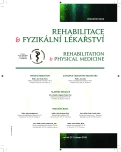Morbus Huntington – What are the Possibilities of Complex Rehabilitation?
Authors:
I. Novotná; D. Pavlů
Authors‘ workplace:
Katedra fyzioterapie UK FTVS, Praha
vedoucí katedry doc. PaedDr. D. Pavlů, CSc.
Published in:
Rehabil. fyz. Lék., 23, 2016, No. 1, pp. 48-54.
Category:
Original Papers
Overview
The authors refer to the fact that Morbus Huntington is a serious hereditary neurodegenerative disease, which is still relatively unknown or neglected by the professional public, which occurs at the rate of about one patient for 10,000 inhabitants. In spite of the fact that it is still presently incurable mortal disease the contribution presents basic characteristics and discussed possible rehabilitation, aimed mainly to influencing of tragic symptoms of the disease, i.e. disorders in motor, cognitive and/or mental and psychic disorders. In the case of a 49 years old patient the authors document their experience in the area of application of rehabilitation procedures with a particular emphasis to physiotherapy and document its positive influence on the progress of the disease and associated quality of life.
Keywords:
m. Huntington, physiotherapy
Sources
1. CUBO, E., SHANNON K. M., TRACY, D. et al.: Effect of donepezil on motor and cognitive function in Huntington disease. Neurology [online]. 2006-10-09, roč. 67, č. 7, s. 1268-1271 [cit. 2015-03-29]. DOI:10.1212/01.wnl.0000238106.10423.00. Dostupné z: http://www.neurology.org/cgi/doi/10.1212/01.wnl.0000238106.10423.00.
2. IRELAND, S.: The HDL Triad to fight HD [online]. Hdlighthouse, 2006. [cit. 2011-02-10]. Dostupné z www: http://hdlighthouse.org/see/index.html?/see/diet/triad.htm.
3. HELDER D. I., KAPTEIN, A. A., van KEMPEN, G. M. J. et al.: Impact of Huntington‘s disease on quality of life. Movement Disorders [online], roč. 16, 2001,č. 2, s. 325-330 [cit. 2015-03-29]. DOI: 10.1002/mds.1056.
4 KLEMPÍŘ, J., KLEMPÍŘOVÁ, O., ŠTOCHL, J., ŠPAČKOVÁ N., ROTH, J.: The relationship between impairment of voluntary movements and cognitive impairment in Huntington’s disease. Journal of Neurology [online], roč. 256, 2009, č. 10, s. 1629-1633 [cit. 2015-03-29]. DOI: 10.5772/32676.
5. KLEMPÍŘ, J.: Poruchy výživy u Parkinsonovy a Huntingtonovy nemoci. 1. vyd., Praha, Mladá fronta, 2013, 46 s. Lékař a pacient. ISBN 978-802-0428-349.
6. KOLÁŘ, P.: Rehabilitace v klinické praxi. 1. vyd., Praha, Galén, 2009, 713 s., ISBN 978-807-2626-571.
7. KLIMEŠ, J.: Klimes.mysteria.cz. Orientační diagnostický test (MMSE) [online]. 1. vyd. 1. ledna 2013 [cit. 2013-04-16]. Dostupné z: http://klimes.mysteria.cz/clanky/psychologie/mmse.htm
8. LIPPERTOVÁ-GRÜNEROVÁ, M.: Neurorehabilitace. 1. vyd., Praha,Galén, 2005, 350 s. ISBN 80-726-2317-6.
9. REBECCA, E. R. et al.: Patient and caregiver quality of life in Huntington‘s disease. Movement Disorders [online]. 2008-04-15, roč. 23, č. 5, s. 721-726 [cit. 2015-03-29]. DOI: 10.1002/mds.21920. Dostupné z: http://doi.wiley.com/10.1002/mds.21920.
10. ROTH, J., UHROVÁ, T., DOUBEK, P., PREISS, M., ŽIDOVSKÁ, J. et al.: The impact of Huntington‘s disease on caregivers. The czech experience. Revista de Neuro-Psiquiatría [online], roč. 65, 2002, s. 168-173 [cit. 2015-03-29].
11. ROTH, J.: Neurodegenerace: jeden mechanismus pro mnoho chorob?. Lékařské listy, roč. 58, 2009, č. 7, s. 17-18. Dostupné z: http://zdravi.e15.cz/clanek/priloha-lekarske-listy/neurodegenerace-jeden-mechanismus-pro-mnoho-chorob-415671.
12. SLÁDEK, B., DENGLER, R. J.: Fyzioterapeutický cvičební program pro pacienty trpící Huntingtonovou chorobou a jinými neurologickými onemocněními. Hradec Králové: Společnost pro pomoc při Huntingtonově chorobě, 2006, 24 s.
13. WARBY, S. C., VISSCHER, H., COLLINS, J. A., DOTY, C. N., CARTER, C., BUTLANDS, S. L., HAYDEN, A. R., KANAZAWA, I., ROSS, C. J., HAYDEN, M. R.: HTT haplotypes contribute to differences in Huntington dinase prevalence between Europe and East Asia. European Journal of Human Genetics, EJHG, 19, 2011, (5), s. 561-566, ISSN 1018 – 4813.
14. ZINZI, P., SALMASO, D., De GRANDIS, R. et al.: Effects of an intensive rehabilitation programme on patients with Huntington‘s disease: a pilot study. Clinical Rehabilitation [online]. roč. 21, 2007, č. 7, s. 603-613 [cit. 2015-03-29]. DOI: 10.1177/0269215507075495.
15. ZUCCATO, C., VALENZA, M., CATTANEO, E.: Molecular mechanisms and potential therapeutical targets in Huntingtonś dinase. Physiological Reviews, 90, 2010, 3, s. 905-981. ISSN 0031 - 9333
16. ŽIDOVSKÁ, J., RŮŽIČKOVÁ, Š., VOJTÍŠKOVÁ, M. et al.: DNA analýza genu Huntingtonovy choroby v české populaci. Psychiatrie, roč. 2, 1998, č. 2, s. 70-73. ISSN: 1211-7579.
17. ŽIDOVSKÁ, J., KLEMPÍŘ, J., KEBRDLOVÁ, V. et al.: Huntingtonova nemoc: zkušenosti s genetickým testováním v letech 1994-2005. Česká a slovenská neurologie a neurochirurgie, roč. 70, 2007, č. 1, s. 72-77. ISSN: 1210-7859.
Labels
Physiotherapist, university degree Rehabilitation Sports medicineArticle was published in
Rehabilitation & Physical Medicine

2016 Issue 1
Most read in this issue
- Decreased Respiratory Muscle Strength – a Possible Reason of Dyspnoea in Patients with Breathing Disorders
- Reliability of the Measurement of Angles in Various Joint Positions: Photogrammetric Software versus Goniometer
- Disorders in Space Perception and Visuospatial Functions in Patients after CMP
- Morbus Huntington – What are the Possibilities of Complex Rehabilitation?
